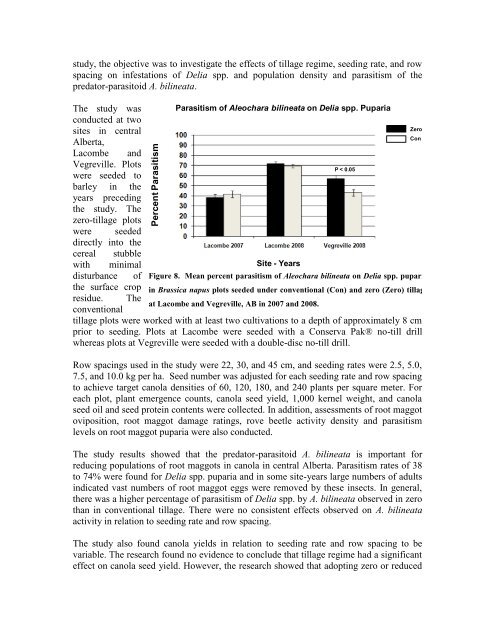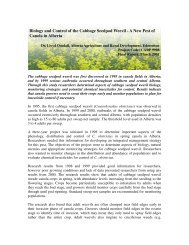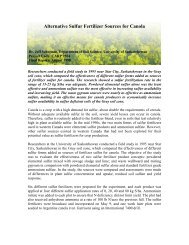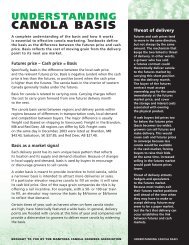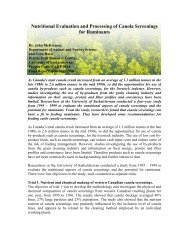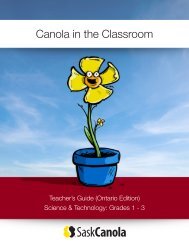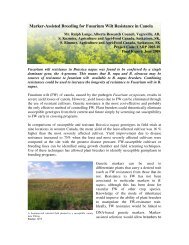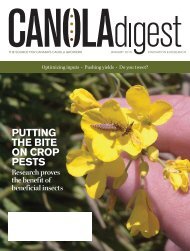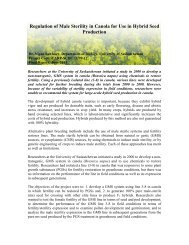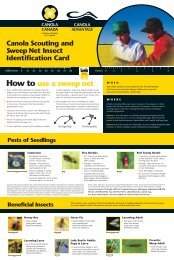Identifying Agronomic Practices that Conserve and ... - SaskCanola
Identifying Agronomic Practices that Conserve and ... - SaskCanola
Identifying Agronomic Practices that Conserve and ... - SaskCanola
Create successful ePaper yourself
Turn your PDF publications into a flip-book with our unique Google optimized e-Paper software.
Percent Parasitismstudy, the objective was to investigate the effects of tillage regime, seeding rate, <strong>and</strong> rowspacing on infestations of Delia spp. <strong>and</strong> population density <strong>and</strong> parasitism of thepredator-parasitoid A. bilineata.The study was Parasitism of Aleochara bilineata on Delia spp. Pupariaconducted at twosites in centralAlberta,ZeroConLacombe <strong>and</strong>Vegreville. Plotswere seeded toP < 0.05barley in theyears precedingthe study. Thezero-tillage plotswere seededdirectly into thecereal stubblewith minimalSite - Yearsdisturbance ofthe surface cropresidue. Theconventionalat Lacombe <strong>and</strong> Vegreville, AB in 2007 <strong>and</strong> 2008.tillage plots were worked with at least two cultivations to a depth of approximately 8 cmprior to seeding. Plots at Lacombe were seeded with a Conserva Pak® no-till drillwhereas plots at Vegreville were seeded with a double-disc no-till drill.Figure 8. Mean percent parasitism of Aleochara bilineata on Delia spp. pupariain Brassica napus plots seeded under conventional (Con) <strong>and</strong> zero (Zero) tillageRow spacings used in the study were 22, 30, <strong>and</strong> 45 cm, <strong>and</strong> seeding rates were 2.5, 5.0,7.5, <strong>and</strong> 10.0 kg per ha. Seed number was adjusted for each seeding rate <strong>and</strong> row spacingto achieve target canola densities of 60, 120, 180, <strong>and</strong> 240 plants per square meter. Foreach plot, plant emergence counts, canola seed yield, 1,000 kernel weight, <strong>and</strong> canolaseed oil <strong>and</strong> seed protein contents were collected. In addition, assessments of root maggotoviposition, root maggot damage ratings, rove beetle activity density <strong>and</strong> parasitismlevels on root maggot puparia were also conducted.The study results showed <strong>that</strong> the predator-parasitoid A. bilineata is important forreducing populations of root maggots in canola in central Alberta. Parasitism rates of 38to 74% were found for Delia spp. puparia <strong>and</strong> in some site-years large numbers of adultsindicated vast numbers of root maggot eggs were removed by these insects. In general,there was a higher percentage of parasitism of Delia spp. by A. bilineata observed in zerothan in conventional tillage. There were no consistent effects observed on A. bilineataactivity in relation to seeding rate <strong>and</strong> row spacing.The study also found canola yields in relation to seeding rate <strong>and</strong> row spacing to bevariable. The research found no evidence to conclude <strong>that</strong> tillage regime had a significanteffect on canola seed yield. However, the research showed <strong>that</strong> adopting zero or reduced


